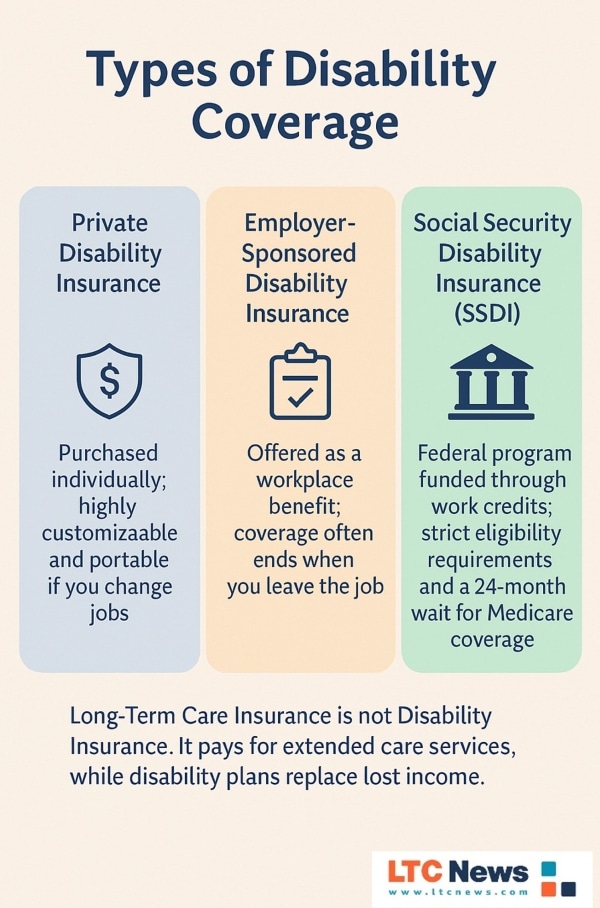Navigating the Claims Process to Filing a Disability Insurance Claim

Table of Contents
- Types Of Disability Coverage: Private, Employer, And Social Security
- Filing A Social Security Disability Claim vs. Private or Employer Disability Claims
- Navigating The Claims Process For Disability Insurance
- Notify Your Employer
- Gather Strong Documentation
- Cooperate With Your Insurer
- When Your Claim is Denied
- The Takeaway for You
Imagine this: you take a hard fall or suffer a serious work-related injury. Suddenly, the job you’ve always done — the one you depend on — isn’t possible anymore, at least for a while. What happens next? How do you keep your life afloat when your income stops but the bills keep coming?
You probably have a disability policy from your employer. Some people have private disability insurance. Disability insurance protects your income if you can’t work due to illness or injury. Some people confuse Long-Term Care Insurance with disability insurance. These policies are very different.
While Long-Term Care Insurance helps pay for ongoing care if you can’t manage daily activities or need supervision due to cognitive decline, the workplace disability policy replaces part of your income.
While you may need long-term care because of the disability, that is often not the case. Knowing how these coverages differ—and how to file a disability insurance claim—can protect your financial security and peace of mind.
Types Of Disability Coverage: Private, Employer, And Social Security
Disability coverage isn’t one-size-fits-all. You may have one, two, or all three types of protection:
- Private Disability Insurance: Purchased individually, often through an insurance agent or broker. It’s highly customizable and can replace a much larger portion of your income than group plans. Policies typically follow you even if you change jobs.
- Employer-Sponsored Disability Insurance: Offered as a workplace benefit, sometimes at no cost to you. These plans can provide short-term and long-term coverage, but may be less generous than private policies and often end if you leave the company.
- Social Security Disability Insurance (SSDI): A federal program you qualify for through work credits and taxes paid into Social Security. SSDI benefits are generally lower than those provided by private or employer coverage and require meeting strict medical and functional criteria.
Social Security Disability Insurance (SSDI) provides monthly benefits to individuals who have worked and paid Social Security taxes but are now unable to work due to a qualifying disability. The amount you receive is based on your lifetime earnings, not on financial need, and averages approximately $1,500 to $1,600 per month in 2025. However, higher earners can receive over $3,000.
Benefits continue as long as you meet Social Security’s medical definition of disability and do not exceed income limits from work.
After you’ve received SSDI for 24 months, you automatically qualify for Medicare even if you are younger than 65, which covers hospital and medical services much like it does for people 65 and older. This connection to Medicare is critical because it provides health coverage when employer-based insurance ends, helping bridge the gap to long-term medical care.
Knowing which type of coverage you have — or how they work together — is crucial before you file a claim. Private and employer disability policies can complement SSDI, helping you cover living expenses while waiting for government benefits to kick in.
Filing A Social Security Disability Claim vs. Private or Employer Disability Claims
The process for Social Security Disability Insurance (SSDI) is handled directly by the federal government, through the Social Security Administration (SSA), while insurance companies manage private and employer-provided disability claims.
With SSDI, you submit an application online or at your local SSA office, provide detailed medical evidence, and often undergo an independent medical evaluation. The review is stricter and typically takes longer, months rather than weeks, because SSA applies a uniform national standard of disability, not your occupation-specific duties.
Private and employer-provided disability policies, by contrast, are governed by your policy’s definition of disability and deadlines. These insurers generally process claims faster and may use your treating physician’s notes plus their own assessments to determine eligibility.
You can file for both simultaneously. In fact, many private and employer plans require you to apply for SSDI if you’re disabled long-term. Any SSDI benefits you receive may offset the amount paid by your private or employer plan, but having both can provide a more stable income while you’re waiting for SSA approval.
Navigating The Claims Process For Disability Insurance
Start the claim process by reading your disability policy carefully. Pay close attention to:
- Definition of Disability: Does it cover your “own occupation” or “any occupation”?
- Waiting Periods and Exclusions: These determine when benefits take effect, and which conditions are covered.
- Deadlines: Missing a filing deadline could delay or even void your claim.
Many insurers now offer online claim submissions. Double-check all paperwork before submitting.
Notify Your Employer
Most disability insurance policies require you to alert your employer promptly. This step ensures that your workplace can provide the necessary documents, such as attendance records or job descriptions, to support your claim. Follow your company’s reporting process, which typically involves HR and your immediate supervisor.
Gather Strong Documentation
Build your claim with clear evidence:
- Medical Records and Doctors’ Statements: Describe your diagnosis, treatment plan, and how it affects your ability to work.
- Employer Statements: Show how your condition impacts your job performance.
- How Long: Is your disability expected to keep you unable to work for a few weeks or months, or much longer, or even permanent?
Keep copies of everything you submit.
Cooperate With Your Insurer
After you submit your claim, the insurer may request additional records or an independent medical exam. Respond promptly and maintain professional and documented communication. This can help speed up the process.
When Your Claim is Denied
If your disability claim is denied, don’t panic—use the appeals process spelled out in your policy.
- Review the Denial Letter: Note the reasons given.
- Gather Additional Evidence: Updated medical records or new documentation can provide valuable support.
- Consider Professional Help: Disability insurance attorneys or Social Security Disability specialists who can offer expertise for complex appeals. Some plans even cover legal costs.
The appeals process is complex, with strict rules and deadlines that must be followed. If your appeal progresses to a formal hearing, having expert legal representation, such as a Dayton, Ohio Social Security Disability lawyer/attorney for those living in the Dayton area, becomes even more critical. Experienced lawyers will possess the specific expertise to build a strong case on your behalf.
Don't Confuse Disability Insurance with Long-Term Care Insurance
Often, people confuse disability insurance with Long-Term Care Insurance. Disability Insurance and Long-Term Care Insurance are both important forms of protection, but they serve different purposes and cater to different needs:
1. Purpose and Coverage
- Disability Insurance: Typically designed to replace a portion of your income if you cannot work due to illness or injury. It focuses on compensating for lost wages and is often provided by an employer.
- Long-Term Care Insurance: Provides coverage for costs associated with long-term care services, whether provided in the home or in a facility. These services might include assistance with daily activities like bathing, dressing, and eating, which traditional health insurance or Medicare does not cover.
2. Benefit Triggers
- Disability Insurance: Benefits are triggered when a medical condition affects your ability to perform your job. The definition of disability can vary, with some policies covering you if you are unable to perform your specific occupation, while others only cover you if you are unable to work in any occupation.
- Long-Term Care Insurance: Benefits are triggered when you are unable to perform at least two of the six activities of daily living (ADLs), such as bathing, dressing, using the bathroom, personal hygiene, or eating, or if you suffer from a severe cognitive impairment like dementia.
3. Duration of Benefits
- Disability Insurance: Generally offers benefits for a defined period, ranging from a few months to until retirement age, depending on the policy.
- Long-Term Care Insurance: Typically provides benefits until a maximum benefit amount is reached. Some policies offer lifetime unlimited coverage.
4. Age and Usage
- Disability Insurance: More commonly utilized by individuals in their working years (typically up to age 65).
- Long-Term Care Insurance: Often used by older adults, although most purchase LTC policies in their 40s or 50s as part of retirement planning.

The Takeaway for You
Your disability insurance provides an income safety net if you can’t work, but it won’t pay for ongoing custodial care or supervision. Long-Term Care Insurance pays for all types of ongoing extended care, including skilled, semi-skilled, homemaker, and companionship services. However, LTC Insurance is usually not provided or offered as a benefit from an employer. Most employer plans are costly or have minimal benefits.
If you haven’t yet planned for the rising cost of long-term care, now is the time to do it. Use the LTC News Cost of Care Calculator to see the financial impact of extended care where you live.
- Take action: Take the time today to review your disability insurance policy and start planning for your long-term care needs. Get accurate quotes from a qualified Long-Term Care Insurance specialist.
Need to file a Long-Term Care Insurance claim? LTC News partners with Amada Senior Care to provide free claim support with no cost or obligation. Their trained experts can walk you through the entire process and help you access benefits quickly and correctly — File a Long-Term Care Insurance Claim.
While you hope never to have a need, filing a claim for disability insurance might be challenging, but it's much easier with the right amount of preparation and knowledge of the process. Begin by familiarizing yourself with your policy, compiling comprehensive paperwork, and alerting your employer promptly when the time comes.
Work with your insurance provider within the specified timeframe they provide and be prepared to file an appeal if necessary. If your claim is rejected, legal representation can give you more leverage.


